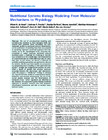Nutritional Systems Biology Modeling: From Molecular Mechanisms to Physiology
dc.contributor.author
Graaf, Albert A. de
dc.contributor.author
Freidig, Andreas P.
dc.contributor.author
De Roos, Baukje
dc.contributor.author
Jamsheedi, Neema
dc.contributor.author
Heinemann, Matthias
dc.contributor.author
Rullmann, Johan A.C.
dc.contributor.author
Hall, Kevin D.
dc.contributor.author
Adiels, Martin
dc.contributor.author
Ommen, Ben van
dc.date.accessioned
2019-01-17T10:04:58Z
dc.date.available
2017-06-14T12:23:41Z
dc.date.available
2019-01-17T10:04:58Z
dc.date.issued
2009-11-26
dc.identifier.issn
1553-734X
dc.identifier.issn
1553-7358
dc.identifier.other
10.1371/journal.pcbi.1000554
en_US
dc.identifier.uri
http://hdl.handle.net/20.500.11850/157404
dc.identifier.doi
10.3929/ethz-b-000157404
dc.description.abstract
The use of computational modeling and simulation has increased in many biological fields, but despite their potential these techniques are only marginally applied in nutritional sciences. Nevertheless, recent applications of modeling have been instrumental in answering important nutritional questions from the cellular up to the physiological levels. Capturing the complexity of today's important nutritional research questions poses a challenge for modeling to become truly integrative in the consideration and interpretation of experimental data at widely differing scales of space and time. In this review, we discuss a selection of available modeling approaches and applications relevant for nutrition. We then put these models into perspective by categorizing them according to their space and time domain. Through this categorization process, we identified a dearth of models that consider processes occurring between the microscopic and macroscopic scale. We propose a “middle-out” strategy to develop the required full-scale, multilevel computational models. Exhaustive and accurate phenotyping, the use of the virtual patient concept, and the development of biomarkers from “-omics” signatures are identified as key elements of a successful systems biology modeling approach in nutrition research—one that integrates physiological mechanisms and data at multiple space and time scales.
en_US
dc.format
application/pdf
en_US
dc.language.iso
en
en_US
dc.publisher
PLOS
dc.rights.uri
http://creativecommons.org/licenses/by/3.0/
dc.title
Nutritional Systems Biology Modeling: From Molecular Mechanisms to Physiology
en_US
dc.type
Journal Article
dc.rights.license
Creative Commons Attribution 3.0 Unported
ethz.journal.title
PLoS Computational Biology
ethz.journal.volume
5
en_US
ethz.journal.issue
11
en_US
ethz.journal.abbreviated
PLOS comput. biol.
ethz.pages.start
e1000554
en_US
ethz.size
12 p.
en_US
ethz.version.deposit
publishedVersion
en_US
ethz.identifier.wos
ethz.publication.place
San Francisco, CA
ethz.publication.status
published
en_US
ethz.date.deposited
2017-06-14T12:29:09Z
ethz.source
ECIT
ethz.identifier.importid
imp59364ce70bfe549664
ethz.ecitpid
pub:35734
ethz.eth
yes
en_US
ethz.availability
Open access
en_US
ethz.rosetta.installDate
2017-07-12T19:59:28Z
ethz.rosetta.lastUpdated
2024-02-02T06:58:09Z
ethz.rosetta.versionExported
true
ethz.COinS
ctx_ver=Z39.88-2004&rft_val_fmt=info:ofi/fmt:kev:mtx:journal&rft.atitle=Nutritional%20Systems%20Biology%20Modeling:%20From%20Molecular%20Mechanisms%20to%20Physiology&rft.jtitle=PLoS%20Computational%20Biology&rft.date=2009-11-26&rft.volume=5&rft.issue=11&rft.spage=e1000554&rft.issn=1553-734X&1553-7358&rft.au=Graaf,%20Albert%20A.%20de&Freidig,%20Andreas%20P.&De%20Roos,%20Baukje&Jamsheedi,%20Neema&Heinemann,%20Matthias&rft.genre=article&rft_id=info:doi/10.1371/journal.pcbi.1000554&
Dateien zu diesem Eintrag
Publikationstyp
-
Journal Article [128876]

